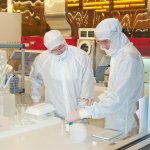100 Years of Growth
From a class of five engineering graduates in 1913, our Faculty now annually graduates more than 800 undergraduate students per year and is among the largest Engineering schools in North America. In the student body, diversity, co-operation, and exchanges grow as we welcome an annual total of almost 260 international undergraduate students and 435 international graduate students.
Five departments of Chemical and Materials Engineering, Electrical and Computer Engineering, Mechanical Engineering, Civil and Environmental Engineering (including the school of mining and petroleum engineering) and Biomedical Engineering share a total of over 4,000 undergraduate students and some 1,500 graduate students, who work and study in outstanding learning environment.
Our Faculty has added four new buildings comprising more than one million square feet of teaching and research space since the turn of the millennium: the Engineering Teaching and Learning Complex (ETLC) (2002); the Electrical and Computer Engineering Research Facility (ECERF) (2002); the Allan P. Markin Canadian Natural Resources Limited Natural Resources Engineering Facility (NREF) (2005). Our Faculty played a leading role in the development and construction of the National Institute for Nanotechnology (NINT), built in 2006. We conduct leading edge research on two floors of the facility. In 2015 the Donadaeo Innovation Centre for Engineering opened to house all administrative offices in the faculty. Approximately 1,700 people work in this building every day, freeing up space in existing facilities to create new teaching and research areas.
Our faculty is among the top engineering schools internationally, especially in the areas of:
- Nanotechnology – transforming technology
- Lab on a chip medical diagnostics
- Advanced sensors
- New materials
- Nano-electronics Energy and environment powerhouse
- Coal and mineral processing
- Fuel cells
- Reaction engineering
- Oilsands tailings and water treatment
- Carbon capture and sequestration
- Biomedical engineering – transforming health
- Implant monitoring
- Targeted drug delivery
- E-health ICT – the knowledge economy
- Wireless communication
- Photonic networks
- Ultra-low power devices
- Advanced control systems
We rank within the top five engineering schools in Canada in terms of number of papers published per professor, total number of papers published, NSERC funding per professor, total amount of Natural Sciences and Engineering Research Council (NSERC) grants, undergraduate enrolment, graduate enrolment, and number of professors. Our Faculty hosts 16 Canada Research Chairs; 11 NSERC Chairs; four Foundation Supported Chairs; and seven Endowed Chairs and Professorships.

